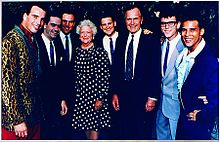
Charles Hardin Holley, known as Buddy Holly, was an American singer, songwriter and musician who was a central and pioneering figure of mid-1950s rock and roll. He was born to a musical family in Lubbock, Texas, during the Great Depression, and learned to play guitar and sing alongside his siblings. Holly's style was country and western music which he performed in Lubbock with his friends from high school.

Waylon Arnold Jennings was an American singer, songwriter, musician, and actor. He is considered a chief pioneer of the outlaw movement in country music, and was one of the most commercially successful country artists from the late 1960s to the late 1980s, with a string of number one hits and critically acclaimed albums following his rebellion against the conservative Nashville recording industry.
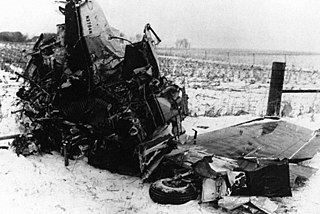
On February 3, 1959, American rock and roll musicians Buddy Holly, Ritchie Valens, and "The Big Bopper" J. P. Richardson were all killed in a plane crash near Clear Lake, Iowa, together with pilot Roger Peterson. The event became known as "The Day the Music Died" after singer-songwriter Don McLean referred to it as such in his 1971 song "American Pie".
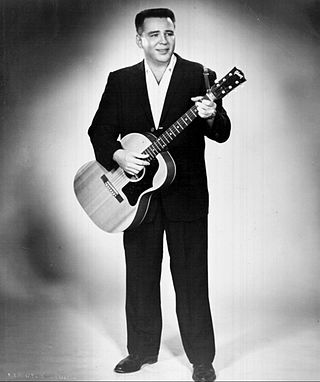
Jiles Perry "J.P." Richardson Jr., better known by his stage name The Big Bopper, was an American musician and disc jockey. His best-known compositions include "Chantilly Lace," "Running Bear", and "White Lightning", the latter of which became George Jones's first number-one hit in 1959.
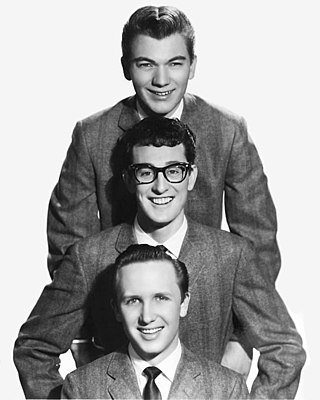
The Crickets were an American rock and roll band from Lubbock, Texas, formed by singer-songwriter Buddy Holly in January 1957. Their first hit record, "That'll Be the Day", released in May 1957, peaked at number three on the Billboard Top 100 chart on September 16, 1957. The sleeve of their first album, The "Chirping" Crickets, shows the band line-up at the time: Holly on lead vocals and lead guitar, Niki Sullivan on rhythm guitar, Jerry Allison on drums, and Joe B. Mauldin on bass. The Crickets helped set the template for subsequent rock bands, such as the Beatles, with their guitar-bass-drums line-up, performing their own material. After Holly's death in 1959, the band continued to tour and record into the 1960s and beyond with other band members through to the 21st century.
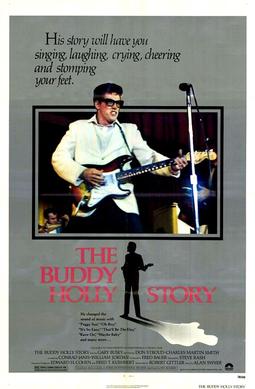
The Buddy Holly Story is a 1978 American biographical musical drama film directed by Steve Rash which tells the life and career of rock and roll musician Buddy Holly. It features an Academy Award-winning musical score, adapted by Joe Renzetti and Oscar-nominated lead performance by Gary Busey. The film also stars Don Stroud, Charles Martin Smith, Conrad Janis, William Jordan, and Maria Richwine, who plays María Elena Holly.
María Elena Holly is the widow of American rock and roll pioneer Buddy Holly. As a receptionist at Peermusic, she met with Holly and his band the Crickets on June 19, 1958, and Holly proposed to her after five hours on their first date. Less than two months later, the couple married on August 15, 1958, in Lubbock, Texas. On February 3, 1959, Buddy Holly died in a plane crash along with fellow musicians Ritchie Valens and The Big Bopper outside Clear Lake, Iowa. After learning of her husband's death from the television news, she suffered a miscarriage the following day and could not attend Holly's funeral in Lubbock.

Jerry Ivan Allison was an American musician. He was best known as the drummer for the Crickets and co-writer of their hits "That'll Be the Day" and "Peggy Sue", recorded with Buddy Holly. His only solo chart entry on the Billboard Hot 100 was "Real Wild Child", issued in 1958 under the name Ivan. Allison was inducted into the Rock and Roll Hall of Fame in 2012.

Norman Petty was an American musician, record producer, publisher, and radio station owner. He is considered to be one of the founding fathers of early rock & roll. With Vi Ann Petty—his wife and vocalist—he founded the Norman Petty Trio.

Joseph Benson Mauldin, Jr. was an American bassist, songwriter, and audio engineer who was best known as the bassist for the early rock and roll group the Crickets. Mauldin initially played a double (standup) bass, then switched to a Fender Precision Bass guitar. After several years with the Crickets, he became a recording engineer at Gold Star Studios, the Los Angeles studio which became the "hit factory" for Phil Spector, Brian Wilson, and other major 1960s rock performers.

Thomas Douglas Allsup was an American rockabilly and swing musician.
Jack Huddle (1928–1973) was an American rockabilly musician and songwriter. He performed and recorded with Buddy Holly early in Holly's career.

Carl Bunch was an American musician and drummer best known for his brief stint as the drummer for The Crickets during the Winter Dance Party Tour in 1959. Bunch's time with The Crickets was cut short by lead vocalist and guitarist Buddy Holly's sudden death in a plane crash on February 3, 1959, popularly referred to as "The Day the Music Died." After Holly's death, Bunch enlisted in the United States Army before relaunching his music career with Hank Williams Jr. and Roy Orbison.
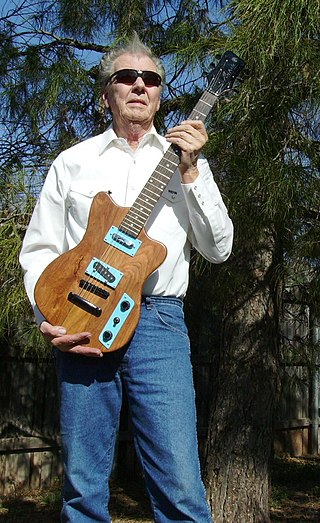
Joseph Sonny West was an American songwriter and musician, best known as the co-writer of two of Buddy Holly's biggest hits: "Oh, Boy!" and "Rave On".
Paul Hipp is an American actor, singer, songwriter and filmmaker.
The Picks was an American vocal quartet that backed Buddy Holly and the Crickets' band on nine of the first twelve Crickets releases on Brunswick in 1957, as well as backing Buddy Holly solos for group sounds. The original members were John Pickering (lead), Bill Pickering (tenor), and Bob Lapham (baritone).
Harold David Box was an American rock and roll musician in the early 1960s. Box was influenced by fellow Texan Buddy Holly, and even took his place as singer of his group, The Crickets, for a short time after Holly's death. Box also collaborated with Roy Orbison, and found local success with his own group, the Ravens.

The Buddy Holly Center is a performance and visual arts center in Lubbock, Texas, dedicated to Buddy Holly as well as the music of Lubbock and West Texas more broadly. The building in which it is located opened as the city's Fort Worth and Denver South Plains Railway depot in 1928. In 1996, the City of Lubbock obtained a sizable collection of Holly-related artifacts from his estate, and the next year it purchased the former depot. In 1999, the new Buddy Holly Center opened as the home of the newly acquired Buddy Holly collection as well as a replacement for the city's Fine Arts Center, which had been established in 1984.
Alex Andreas is an English actor/singer. He trained at the London School of Musical Theatre (LSMT), and is probably best known for his portrayal on stage of The Big Bopper in The Buddy Holly Story, between 1996–2001, in Hamburg, Germany, and on tour in the UK. He is currently playing Tony Scibelli in The Bodyguard Musical UK No. 1 Tour.

Alan Janes is an English writer and producer who has worked in TV, film, radio and theatre. His musical Buddy – The Buddy Holly Story ,ran for over 14 years and almost 6,000 performances in London's West End, and has been on tour in the UK for 17 years. Buddy has also played Broadway, five US national tours, eight years in Germany, three years in Australia and New Zealand, and other productions around the world, leading to the show being billed as "The World's Most Successful Rock 'n' Roll Musical".

